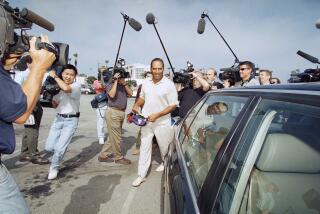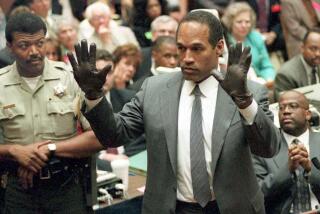The Real Battle Behind the Sequester Debate: Who’s on Simpson’s Jury?
- Share via
To sequester, or not to sequester, that is the question facing Superior Court Judge Lance A. Ito in the O.J. Simpson murder case.
Deputy Dist. Atty. Marcia Clark has urged Ito to sequester a jury to ensure that the state receives a fair trial. The defense team, led by Robert L. Shapiro, does not want jurors sequestered during what could be a long trial.
Under the Sixth Amendment, it is the accused who is entitled to a fair trial, and the accused whose rights Ito is constitutionally compelled to protect. Any “right” the government has to a fair trial is derivative. By definition, a fair trial for Simpson is a fair trial for the state.
So what does Clark really want?
There are no reported cases of a prosecutor ever requesting a judge to sequester a jury. Sequestration only occurs when the media, as it is wont to do from time to time, exploit a story to the point of creating a “carnival atmosphere at trial,” making any verdict superfluous to a media-goaded lynching.
The case most relevant to Simpson’s in terms of the potentially adverse effects of pretrial publicity is that of Dr. Sam H. Sheppard, whose conviction for murdering his wife was overturned by the U.S. Supreme Court. In Sheppard’s case, the court noted that, “Beyond doubt, the press had shown no responsible concern for the constitutional guarantee of a fair trial; the community from which the jury was drawn had been inundated by public- ity hostile to the defendant.”
The Simpson case is different. For one, the latest Harris poll shows strong community divisions on Simpson’s guilt in the murders of his former wife and a friend three months after his arrest--and in the context of the greatest media circus since the Scopes “Monkey Trial.” Also, unlike Sheppard, Billy Sol Estes, Charles Manson and other well-known defendants, Simpson is not the only party suffering from bad press. The Los Angeles Police Department, the coroner and the district attorney have all made mistakes in the case, as the press keeps reminding them.
Juries only get sequestered when the media chooses frenzy and ratings over responsibility. There is virtually nothing a judge can do to discipline an irresponsible media--or worse yet, a pseudo-press for which factual renditions are more likely cosmic coincidence than the result of planning.
What is sickening to any prosecutor or defender who has tried a high-profile murder case is the cavalier disdain that tabloid shows have for accurate reporting. Last night’s “recreation” was probably watched by one or more jury members and that error-filled fictional presentation probably stuck in at least one juror’s mind because it is “visually indelible” even though it is false.
But the prosecution in the Simpson case is not worried about the tabloids, print or electronic. What Clark seeks to achieve through a sequestered jury is to eliminate certain groups of prospective jurors whom the defense wants: blue-collar workers, people with children in the home, professionals and students, among others. What she wants are jurors who fit this profile: authoritarian personality, older than 50, white or Latino from a demographically conservative area, first- or second-generation Asians, “go-alonger’s” rather than “show-me’s,” women who hate sports, women who have been abused, police supporters and conformists. More women than men.
The defense wants younger African-Americans (a vast number of whom believe Simpson will not receive a fair trial), younger whites and Latinos, men, especially men who work with machines or tinker, “show-me’s,” women who will not identify with Nicole Brown Simpson, third-generation Asians or later, anti-authoritarians, sports fanatics, people who have had bad police experiences and those who are racially tolerant. More men than women.
The battle to sequester, then, is not a battle to protect Simpson’s right to a fair trial. It is a battle over what the ultimate jury pool will look like.
The Sixth Amendment requires that the jury pool reflect a cross-section of the judicial district in which a case is tried. Sequestering would increase the number of prospective jurors who claim hardship, and hardship removals are always higher for those lower on the socioeconomic ladder--racial and ethnic minorities. And it is this group whom polls show to be more likely Simpson sympathizers.
According to the 1990 census, the adult population for the Central Judicial District, where the trial will unfold, was 20% white, 21% black, 48% Latino and 11% Asian. Those percentages, however, do not reflect the large undercount of Latinos and blacks; they must be adjusted upward, according to a recent federal appellate-court decision. By contrast, the last survey available from the jury commissioner shows that Central District jury pool was 50% white, 22% black, 18% Latino and 10% Asian.
In other words, the statistics reveal an extreme overrepresentation of whites and an extreme underrepresentation of Latinos in the pool.
Judges are not fond of lawyers who point out such demographic anomalies, though most criminal lawyers just let them ride.
In the Simpson case, however, if it looks as if the jury pool is getting stacked, one suspects that Simpson lawyers Shapiro and Johnnie L. Cochran Jr. will not “let them ride.” For if Ito chooses to sequester the jury, the effect would be to increase the percentage of whites available in the pool. Senior citizens and child-less government workers who have infinitely paid jury service would have a greater chance of ending up as jurors. And these jurors are more likely to be conservative, harbor racial biases and inclined to convict.
But Ito may avoid ever getting around to the sequestering problem. After damaging false news reports were broadcast by some TV stations last week, Ito announced that he was “beyond outrage.” If news directors fail to heed his threat to cut off the courtroom cameras by continuing to air such false reports, the need to sequester would become less compelling.
There is no First Amendment right that entitles television stations to broadcast the proceedings live. Rule of the Court 980 asserts: “The court may refuse, limit or terminate film or electronic media coverage in the interests of justice to protect the rights of the parties and the dignity of the court, or to assure the orderly conduct of the proceedings.”
Ironically, it may be TV pundits rather than jurors who find themselves sequestered in a hotel cut off from the news.
More to Read
Sign up for Essential California
The most important California stories and recommendations in your inbox every morning.
You may occasionally receive promotional content from the Los Angeles Times.













